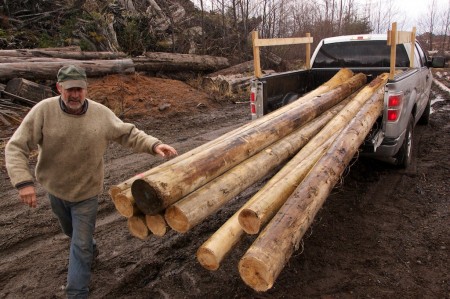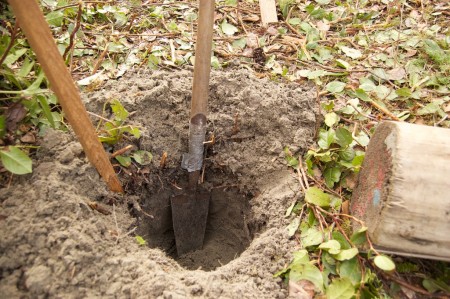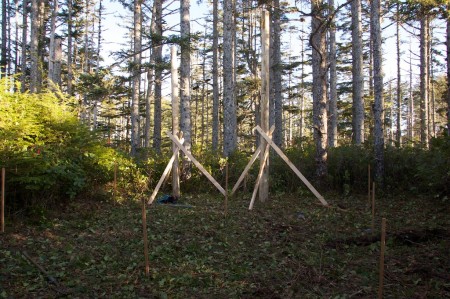A proud day, I’ve erected my first two poles. I’m building pole construction vs. regular framing. All the foundations and structural supports for the cabin – floor to roof – rest on 9 to 12 vertical poles at eight-foot intervals, instead of say a concrete slab. Wood left in its natural round form is almost 20% stronger than wood milled rectangular. Think of how much wood is up in the air with a tall tree, waving in the wind. Now imagine if that was a single piece of milled wood instead.
Pole construction buildings are: relatively simple to build; can be built on steep land without grading; are more resistant to earthquake, flood, and wind; and because they use less materials, are less expensive to build.
Plus, where I’m building I can scavenge some of the raw materials. Namely the poles. Or as what actually happened, Rich and Lisa scavenged the poles. They spent some time in Masset inlet last winter in their 16-foot aluminum skiff beachcombing for good cedar logs. Cedar is naturally rot-resistant, so no need for the toxic chemicals usually applied to poles (think of utility poles) to keep them from degrading in the ground.
They waited until the highest tides of the month to float the logs they wanted, then towed them out into deeper water and secured them with a rock anchor. When they had the lot they wanted, they towed them in to where a heavy equipment operator could haul them out of the water.
So there were some beautiful, straight, positively buxom cedar logs waiting for me down at a mill yard down in Port Clements, about a 40-minute drive, down-island.
Yesterday, Rich and I (and Harvey and Boone, the two dogs) went down in his truck to go haul some back. From past experience, Rich knew that 16 feet was the maximum length of log, placed butt-end first that he could carry in the short box of his Ford F150. Any longer and they’d tip out. This was the deciding factor on how long my poles would be and thus how tall the cabin (which reminds me of an explanation I’d heard about the relationship between the width of a horse’s ass and the size of the Space Shuttle).
They don’t call him Rapid Richie for nothing, not long after we’d arrived in the mill yard he had the chainsaw out and was cutting logs as fast as I could measure out 16-foot lengths. We used the peavey, a tool about the length of a pickaxe with a big metal spike on one end and a hinged, mono-toothed jaw that would hook around the log, to maneuver them by leverage. The logs ranged from about 8 inches to about a foot in diameter. Together we hoisted nine of the poles into the bed, the tailgate straining under the load.
Back on North Beach we backed the truck into the start of the trail to the cabin site and heaved them out again. I still needed three more and Rich needed a couple shorter ones for the front porch on the Ravenshoe. So I went back down, alone this time, to pick up the rest.
He’d made it look easy but I managed to get my chainsaw blade stuck in pinched cuts and hit dirt a couple times (luckily not with his chainsaw but my own). After some serious grunting, the logs made their way into the truck bed and got tied down.
In my pocket, I also had a scrap of paper with the lumber that I needed to pick up at Abfam (a contraction of Abbott Family), a family-run sawmill just up the road from where I’d picked up the poles. Eight , 2x6x16’s, 10 – 2x6x10’s, and 20 – 2x4x8’s, ended up on top of the five logs for a groaning heap of wood.
Day Three, and I had the raw materials needed to start actual construction. Without Rich and Lisa’s beachcombing, just finding the12 poles alone could have otherwise taken me as long.
Upon my return, I was rewarded with a meal of venison medallions and vegetable stir-fry at Rich and Lisa’s. Their home is a testament to what can be accomplished with just a chainsaw and natural decor. It has a proud view of the water and several types of wood gracing the interior. Whalebones festoon the front porch and a bear skull sits on a side table.
This morning, as Rich had suggested, I spent the first couple hours in the cabin clearing, with a cup of tea and a chair thinking about orientation of the cabin. I then planted my stakes into the ground.
These stakes would be where I would plant the poles. And I had to get them square. Which sounds dead simple but you’d be surprised how easily you can have correct length sides on a footprint that isn’t square (a.k.a. a parallelogram). The way to find out if you’re square is to measure across the diagonals. They should be equal. Easy, right?
As they say, simple is not easy. Not if you’re doing it right (meaning in the erratic, trial-and-error way, which seems to be the way of choice up in here). First, you pound a stake into the ground, hooking the tape measure and pulling it out to where you figure your next stake should be then pound that one in. (Before then though, the tape will usually slip off and come slithering back at you. For maximal fun, this process should be done alone.)
Repeat a bunch more times and you think you’re done but a cross-measurement will reveal that you’re off by a couple inches – somewhere. Re-measure the sides, find them to be correct. Do some trigonometry in your head, randomly pull up a stake and replant it. Measure the diagonals and find out that you’re even more off. Repeat ad nauseam.
I’m sure there’s an easier, fool-proof way of doing this, in fact, I know there is because I read about one in a cabin-building book I brought, but this is the way that Rich does it, and so that’s good enough for me.
A few hours later, I was ready. I just needed to get the materials up to the building site.
The path I’d cut led from where an excavator had dug out a road and led 50 feet up a gentle incline, between some spruce trees, to where the cabin would be. The dimensional lumber was just a matter of shuttling back and forth with manageable loads. However I needed to drag the poles up the winding path like an ant stealing a hotdog from a picnic.
I wound a thick maritime rope with a eye spliced into it around one end of a log and wound the rest of the rope around one arm and over my shoulders. And heaved, the whole thing slid maybe four inches. In sub-foot increments I’d drag the logs, one by one up the path. This chance to drag big sticks through the dirt is exactly the kind of thing that I’d apparently been hungering to do.
Anyway, I had time in between each pole to rest. There wasn’t enough space in the clearing to bring all the poles at once so I’d just haul them as I planted them.
Planting the pole was as simple as it sounds. You pull the pole up to the stake next to which it was to be planted. Eyeball the size and shape of the butt. Dig a hole, about a foot deep and a little larger than the size of the pole, keeping the sand close by to fill in the gap.
Then the fun starts, hoik up the other end of the pole and get underneath it, then, like the soldiers raising the flag at Iwo Jima, except you’re solo, work your way along the pole lifting it overhead. If all lines up correctly for you, as you reach a good level of verticality, the butt will slide into the hole and you’ll have a freestanding pole held by gravity and your sweaty little hands.
If all’s to your satisfaction you can fill in the gaps around with sand, packing it down with the butt end of your shovel. The pole, all 15 feet of it, should stand up straight, at least long enough for you to run and get some 2 x 4s and nail up a tripod around it.
Notice, that I mentioned sand. The exact nature of the soil into which the pole is being planted has a large bearing on how deep the pole needs to be. In my cabin books, there are complex tables that give hole depth according to pole height and different soil conditions. Sand is the absolute best. But nowhere in those tables do I find a depth as shallow as a foot.
But, like I said, if it’s good enough for Rich, it’s good enough for me. As far as I know not one of his structures has fallen down in the last three decades. Being just off the beach, we hit sand a couple inches down and there’s no frost line to worry about (I think).
Following that process I got my first two poles up. This was the part that I’d been most nervous about, handling the heavy poles and tweaking a back or having one drop silently on me from behind like a big deadfall. Plenty of time still for that.



